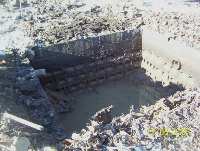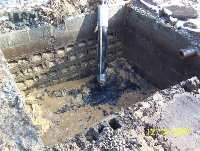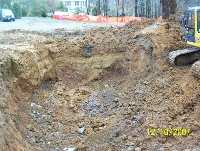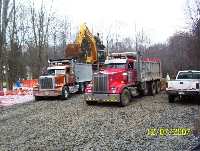Spring Lane Well Contamination Site
Spring Lane
Warren Township, Somerset County
PI #: G000011456
BLOCK: Various LOT: Various
Office of Community Relations (OCR)
(609) 984-3081 | (800) 253-5647
SITE DESCRIPTION/RESOLUTION OF ENVIRONMENTAL CONCERNS:
As of 23 January 2008
The Spring Lane Well Contamination Site is located in Warren Township,
Somerset County. The site is situated just off Mountain Avenue between
Stirling Road and Hillcrest Road in a primarily residential area of single-family
homes.
In 1991, the Warren Township Board of Health and the New Jersey Department
of Environmental Protection (NJDEP) sampled more than 100 potable wells
in the area and found ground water contamination in the area. Eleven potable
wells contained the contaminants of concern (COCs): carbon tetrachloride,
chloroform, and tetrachloroethylene, and their breakdown products, above
Ground Water Quality Standards (GWQS). Twenty-three domestic wells were
sealed and abandoned at the time and residences within the area were connected
to the public water in 1995. All of the homes in the Spring Lane Well
Contamination area are currently being serviced by public water mains.
An investigation to locate the source of the contamination and to determine
the nature and extent of the groundwater contamination was conducted by
the NJDEP from 2003 to 2005. Soil, groundwater, surface water and sediment
samples were collected and analyzed throughout the area. Additionally,
NJDEP conducted indoor air testing at six homes in the area in 2002 to
determine whether contaminants were volatilizing from the ground water
and entering the buildings, but no organic vapors were detected.
Based on the results of the remedial investigation, it was determined
that the likely source of the widespread ground water contamination originated
in the back yard of the residence at 69 Mountain Avenue, in Warren Township.
Anecdotal evidence suggested that the former owner had used a drain within
a barn-like structure on the property to wash machine parts, likely using
carbon tetrachloride. Carbon tetrachloride is a chlorinated solvent that
was historically used to clean machine parts, often leaching heavy metals
from the machinery in the process.
Once the source of contamination was identified, NJDEP mobilized to excavate
and remove the contaminated soil. The general dimensions were 40 feet
by 50 feet with a depth of 16 feet. The material was excavated and removed.
A total of 48 truckloads (approximately 1,440 tons) of contaminated material
were disposed off-site.
During the course of the excavation, an old septic system was discovered.
The septic system was constructed of masonry block and measured 7 feet
by 7 feet with a depth of 7 feet and contained water and oily sludge.
The sludge was contaminated with heavy metals, specifically lead with
a total concentration of 2,130 ppm. A total of 2,000 gallons of water
and sludge were pumped out and disposed from this septic tank area. Approximately
100 tons of contaminated soil from around the septic system, in addition
to the 1,440 tons previously removed, were excavated and removed off site.
The back yard of the residence is being restored to its original condition.
Ground water contamination will be addressed by injecting nano-sized
particles of iron or another reducing agent to remediate the contaminated
ground water. Reducing agents can aid in the degradation of carbon tetrachloride
to a mixture of relatively harmless products. NJDEP will monitor ground
water for approximately seven years and will establish a Classification
Exception Area (CEA) for the ground water. A ground water CEA serves as
an institutional control by providing notice that there is ground water
pollution in a localized area caused by a discharge at a contaminated
site.
|

Please be advised that these
cases labeled by OCR as inactive may still be undergoing remedial
activities but OCR has no involvement. Documents that are available
on this page associated with the inactive list may not reflect
the current status of a case.
Related Links
Photos
Click on the photos for larger versions.

1. Source of the contamination prior to excavation. |

2: This old septic system contained sludge contaminated
with heavy metals, specifically lead. |

3: Note the presence of sludge in the
septic system. |

4: The removal of contaminated soils required
an excavation 16 feet deep. |

5: Forty-eight truckloads (approximately
1,440 tons) of contaminated material were removed from the site. |
|




